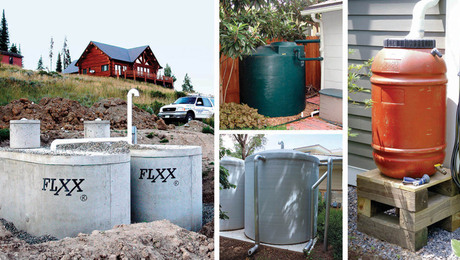A friend just purchased a 25 year old house in NW Ohio and asked me for energy saving tips of less than $199 for her to implement over time from her cash flow I figure this could be a useful thread, so let’s post some tips and discussions Please include any relevant climate info (what is cost effective in Vermont might not be in Arizona….)
Discussion Forum
Discussion Forum
Up Next
Video Shorts
Featured Story

There's a constant source of clean water for you to use, and all you have to do is collect it.
Featured Video
Video: Build a Fireplace, Brick by BrickHighlights
"I have learned so much thanks to the searchable articles on the FHB website. I can confidently say that I expect to be a life-long subscriber." - M.K.


















Replies
Furnace and water heater make-up air - In NW Ohio
The house currently draws the combustion air for the furnace and water heater from the conditioned air of the house, sending some significant heating (and cooling) dollars up the flue.
I'll be adding an air supply to the crawl space and attic and closing off the air supply registers in the wall of the utility room.
FWIW, I'll be putting some sort of 1/2 circle wire cover over the supply from the crawlspace - during home inspections I've seen many such supplies covered over with storage. I'm thinking perhaps of converting some sort of wire dish drainer to this use.....
Cost: Maybe $10 for the "cover" and another $10-20 for return air registers. (Actually, in this case I'll just reuse the existing register covers) and 1-2 hours (with a union size coffee break...{G})
That subject has been beaten to death in publications. The only thing I can add is to close the storm windows. It's amazing the number of them you see in the dead of winter that are still open.
>>That subject has been beaten to death in publications.
True. I'm interested in what contractor and construction types have to say, in addition to what some mag writers and editors have given us.
Not sure what you are doing with this. Are you ducting an insulated combustion air supply of sorts? If you are simply drawing air from the crawl by installing a vent, then your energy equation isn't really improved.
>>Not sure what you are doing with this. Are you ducting an insulated combustion air supply of sorts? If you are simply drawing air from the crawl by installing a vent, then your energy equation isn't really improved.
Because I'd rather use air for combustion that no one has paid to heat before sending it up the flue.
I understood your intent, I think, and agree with it. I just didn't understand how you were doing it. If you punch a hole in the crawl for the purpose of using it for combustion air, you are forcing the crawl to be colder. Better to duct your combustion air. It's no totally free lunch to bring cold combustion air into the furnace, either, yaknow. Since I should ventilate my house anyway, I don't think I'd have a problem using that ventilation air for combustion in my furnace (although I've never run the cfm numbers on this).
I'm opening a air supply
I'm opening a air supply between the utility room and the crawl (and attic) and closing off the openings to the conditioned space.
Yes, I suppose supplying cooler air from the crawl might bring down the flame temp a bit, but the 20 degree+/1 (or even 50 degree) difference is pretty small compared to the final temp of the flame and in the heat exchanger.
Attic Hatch insulation -- NW Ohio
I'll be adding foam insulation to the top of the attic hatch (with fire stopping on the edges and top on top of the foam, and adding "rubber" weatherstripping around the edges
Cost: Less than $20, and 1-2 hours estimated.
Can you explain this "fire stopping?
A furnace tune-up by somebody that is competent. And I'm NOT including those $69 dollar specials. I've seen a light coating of dust on the fans change the temperature rise by 10 degrees. That is like your car spinning it's wheels on ice.
I mean that the foam should be covered by drywall or something similar
Seal the holes into the attic. All the electrical wiring holes and cieling light fixtures need caulk or foam as do the plumbing pipeswhere thry penitrate into the attic. It is astounding how much of your heat leaks out through the stack effect into the attic.
A 25-year-old house should be pretty good, and likely not a lot that can reduce actual heating costs much, without spending more money. But one thing that may be worth it (in terms of comfort if not actual savings) is to pull off the interior trim on windows and foam around them. (Be sure you give good instructions about using low-expanding foam and carefully covering nearby surfaces if using the solvent-based stuff.)
Seal your ducts, foam in any air gaps going up to the attic.
Personally I'd also invite a small scale new construction insulation contractor known for really good looking work to lunch--cost $15 but you might convince him to save rather than trash his insulation bat scraps which you then toss into the attic. Guys who's work looks perfect toss out a lot of scraps. When you get enough for r60 or so go rent a blower and blow in just enough to fill in gaps.
A carpenter friend insulated his attic for free this way--didn't even rent a blower but saved bags of lose insulation from remodels.
Just a SWAG, but how about installing an insulation blanket on the HW heater - especially if you are going to make it be in unconditioned space.
Generally not worth it, unless it's a very old water heater.
I'd go for the air sealing
I'd go for the air sealing ... everywhere. It's a pain to do the labor, but it's a cheap fix that has to have just about the best payback in the business. Also, if you do it yourself, it forces you to 'tune into' your house in ways that can be beneficial down the road.
The biggest air sealing task that is quite easy and can give you very good immediate and noticeable performance: Install door weatherstripping. Only use quality extruded metal weatherstripping w/ the 'rubber' seal. Don't forget the door sweep. Like anything, the devil is in the details with this stuff, so installing it right makes a big difference!! This weatherstripping is like $12+ for the package (top/sides only, I think), but it is worth it and generally much more durable and affective than other cheap methods. Routing a EPDM slot and installing a rubber bulb is also probably a very good method, but not usually accessible by a DIYer.
I also agree w/ duct sealing ... very important and not to expensive.
When all that is done ... turn to make sure the exhaust fans are doing the job right. You wouldn't want to create a problem, now would we?
I'll go with Programmable
I'll go with Programmable Thermostat. And a clean furnace filter.
A good prog stat may cost more than $100.
Dirty filters filter better and usually use lower fan energy consumption though ... up to a point, that's OK.
Dirty filters filter better and lower energy consumption? Now I understand.
A dirty filter does filter better. To clarify ... the FAN energy decreases when the filter is dirty. Like putting your hand over a vacuum cleaner hose ... the fan energy dramatically goes down (that's why it speeds up; it's doing less work).
Here's one that bit me for a
Here's one that bit me for a few years:
There's a shed dormer on the back of our house that has a bathroom at each end. There's a fart fan in each bathroom. See drawing.
I always wondered why snow on the roof had a big divit over each bathroom and there were huge icicles hanging from the gutters.
Then it dawned on me.... there's no insulation above the fart fans.... a thermal bridge causing snow to melt.
Luckily I don't have soffits yet, so this summer I did my best to work in a bit of fiberglass above the fan bodies. Not perfect, but it's an improvement.
In hindsight I should have built a foam box around the fart fans.
Hope this helps someone.....
The pattern of snow/frost on a roof can provide good hints about the areas of air/heat leakage through the ceiling. Always a good idea to observe it on a few occasions through the winter.
How To Reduce Your Energy Bills / Energy Conservation Begins at Home
Imagine leaving a window open all winter long -- the heat loss, cold drafts and wasted energy! If your home has a folding attic stair, a whole house fan or AC Return, a fireplace or a clothes dryer, that may be just what is occurring in your home every day.
These often overlooked sources of heat loss and air leakage can cause heat to pour out and the cold outside air to rush in -- costing you higher heating bills.
Air leaks are the largest source of heating and cooling loss in the home. Air leaks occur through the small cracks around doors, windows, pipes, etc. Most homeowners are well aware of the benefits caulk and weatherstripping provide to minimize heat loss and cold drafts.
But what can you do about the four largest “holes” in your home -- the folding attic stair, the whole house fan or AC return, the fireplace, and the clothes dryer? Here are some tips and techniques that can easily, quickly and inexpensively seal and insulate these holes.
Attic Stairs
An easy, low-cost solution to this problem is to add an attic stair cover. An attic stair cover provides an air seal, reducing the air leaks. Add the desired amount of insulation over the cover to restore the insulation removed from the ceiling.
Whole House Fans and AC Returns
An easy, low-cost solution to this problem is to add a whole house fan cover. Installed from the attic side, the whole house fan cover is invisible. Cover the fan to reduce heating and air-conditioning loss, remove it when use of the fan is desired.
Fireplaces
A recent study showed that for many consumers, their heating bills may be more than $500 higher per winter due to the air leakage and wasted energy caused by fireplaces.
An easy, low-cost solution to this problem is to add a fireplace draftstopper. Available from Battic Door, a company known for their energy conservation products, a fireplace draftstopper is an inflatable pillow that seals the damper, eliminating any air leaks. The pillow is removed whenever the fireplace is used, then reinserted after.
Clothes Dryer Exhaust Ducts
An easy, low-cost solution to this problem is to add a dryer vent seal. This will reduce unwanted air infiltration, and keep out pests, bees and rodents as well. The vent will remain closed unless the dryer is in use. When the dryer is in use, a floating shuttle rises to allow warm air, lint and moisture to escape.
If your home has a folding attic stair, a whole house fan, an AC return, a fireplace, and/or a clothes dryer, you can easily, quickly and inexpensively seal and insulate these holes.
Mark D. Tyrol is a Professional Engineer specializing in cause and origin of construction defects. He developed several residential energy conservation products including an attic stair cover, an attic access door, and is the U.S. distributor of the fireplace draftstopper. To learn more visit http://www.batticdoor.com
A setback thermostat.